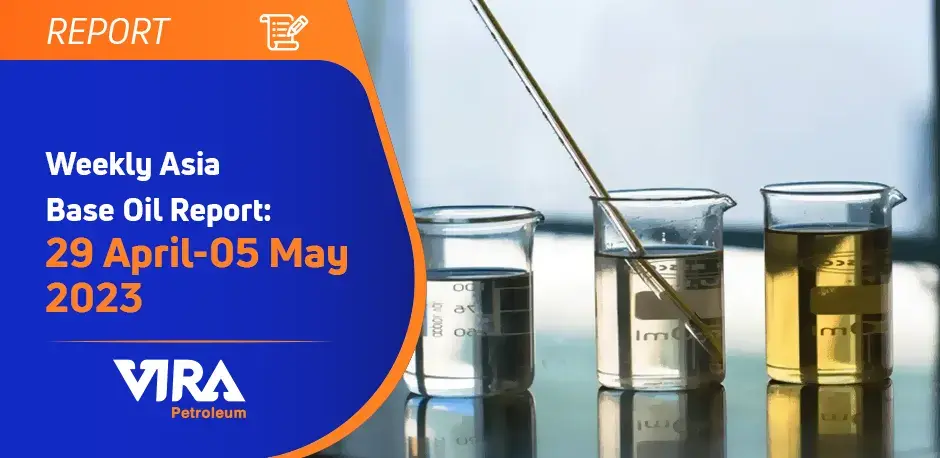Persistent demand, coupled with sufficient stockpiles, maintained price stability in Asia’s markets. While certain markets exhibited less robust conditions, impending maintenance operations in the region were anticipated to preserve a balanced-to-tight supply in relation to consumption rates. In some nations, local holidays contributed to a slight decrease in activity throughout the week; however, trade was expected to rebound as participants eagerly sought to negotiate May shipments.
read more : Weekly Asia Base Oil Report: 22-28 April 2023
read more : Weekly Asia Base Oil Report: 06 -12May 2023
Crude Oil’s April Influence on Base Oil
Market participants also kept a watchful eye on fluctuations in crude oil and feedstock prices, as their values remained highly volatile. Crude oil futures experienced a 4% drop on Wednesday, exacerbating the sharp declines from the previous session following the United States Federal Reserve’s decision to increase interest rates.
This move intensified apprehensions regarding the nation’s growth rate and its potential effects on the global economy. On May 3rd, Brent futures settled at $72.33 per barrel – the lowest closing price for the global benchmark since December 2021, as reported by Reuters.
Crude oil prices experienced a decline in recent weeks. On May 4, Brent July futures traded at $73.15 per barrel, down from $78.03/bbl for June futures on April 27. Similarly, Dubai front month crude oil (Platts) financial futures for June settled at $71.13 per barrel on May 3, compared to $76.74/bbl on April 19.
These fluctuations in crude oil prices have had an impact on the base oils and lubricants markets. Economic uncertainties and concerns about a global recession have influenced market participants.
Despite increased travel and mobility after the COVID-19 pandemic restrictions, consumers in many countries remained cautious due to growing inflation and rising interest rates. This cautious approach is expected to affect not only automotive applications but also the industrial, marine, and construction segments.
Order : recycle base oil
Base Oil price In China
Reports over the weekend indicate that the Chinese economy is facing uncertainties despite expectations of a strong recovery following the relaxation of strict COVID-19 policies. Industrial production has been less robust than anticipated. However, during the recent five-day Labor Day holiday, millions of Chinese travelers flocked to train stations and tourist spots, signaling optimism that the pandemic crisis was waning and a consumer-led economic rebound was underway.
This surge in domestic travel highlights the significant role of Chinese consumers in driving the country’s economic recovery. Although manufacturing activity has contracted, the travel enthusiasm contrasts with the global economic challenges, such as high interest rates, inflation, and weaknesses in financial systems faced by the US, Europe, and Asia.
The changing market conditions have impacted the demand for base oil and lubricants, resulting in fewer imports reaching China compared to earlier projections. The domestic production of base oil in China has been sufficient to meet the consumption needs, and there have even been surplus cargoes available for export.
For instance, discussions were held regarding a 3,800-metric ton cargo shipment from Nantong to Mumbai in mid-May. Additionally, smaller cargoes were being considered for shipment to China, including a 1,500-ton parcel comprising two grades expected to be shipped from Malacca, Malaysia, to Zhuhai in the first half of May.
Another 2,000-ton cargo shipment from Yeosu, South Korea, to Nansha in late May was also mentioned. Some plants in China have been operating at reduced rates due to market dynamics and inspections, while a few facilities have undergone maintenance shutdowns. As the spring season comes to an end, it is anticipated that Chinese base oil demand will decline in the upcoming weeks.
Base Oil Trends In Asia
Conversely, there was a noticeable increase in demand from other Asian countries, especially in those regions that recently observed the holy month of Ramadan, which had previously experienced slower activity. In the coming months of May and June, planned turnarounds at several base oil facilities in Asia may lead to limited supplies and potential price hikes.
Order: rubber processing oil
Base Oil Trends In Southeast Asia
In Southeast Asia, the availability of certain grades, particularly within the API Group I segment, has been affected by both planned and unplanned production outages. Following a fire in early April, an Indonesian plant was anticipated to resume operations. Additionally, a major facility in Singapore had scheduled maintenance for some of its base oil trains starting from the end of April and lasting for approximately two months. These shutdowns were expected to create a tighter spot availability in the region. Buyers in Southeast Asia were actively seeking regional cargoes, considering a 2,200-ton shipment from Yeosu, South Korea, to Haiphong, Vietnam, in early June. Another 2,000-ton shipment from Sri Racha, Thailand, to Singapore was planned for the first half of May.
Base Oil Trends In Northeast Asia
In Northeast Asia, a South Korean producer of Group II/Group III base oils was scheduled to commence an extensive turnaround in late May, leading to a reduction in spot supply. Furthermore, a Japanese refiner had plans for a two-month turnaround at its refinery starting in May, which would likely impact base oil production and limit availability from that particular producer.
Base Oil Trends In India
In India, the buying interest seemed to have diminished due to prevailing uncertainties that affected business sentiment. The direction of base oil prices remained unclear, influenced by fluctuating currency exchange rates and volatile crude oil prices. Nevertheless, the arrival of substantial cargoes from the United States provided some reassurance, mitigating concerns of potential supply shortages during a period when a domestic producer’s plant was encountering production challenges.
Group I and Group II Prices in Asia
Group I supplies remained limited, while availability of Group II has become tighter as Northeast Asian suppliers shifted their focus to more lucrative markets. The spot supplies of Group II and Group III from South Korea were strained due to a planned plant turnaround starting at the end of May and steady demand from other regions.
However, the reduced availability may be offset by increased volumes from the Middle East and the U.S., where domestic demand has been sluggish. It was reported that around 18,000 tons were shipped from Yanbu, Saudi Arabia, to Mumbai in late April. There were also discussions about Spanish products being transported to India, with approximately 17,000 tons purportedly shipped from Cartagena, Spain, to Mumbai in late April.
Due to higher offers and limited regional availability, Group II prices in India have seen a slight increase of approximately $10 per metric ton. Despite the tightening supply situation, discussions were held regarding the shipment of several South Korean cargoes to India this week.
It was anticipated that around 5,000 to 7,000 tons would be shipped from Yeosu to Mumbai at the end of May or early June. Furthermore, a 5,000-ton parcel was under consideration for shipment from Pyongtaek and/or Yeosu to Chennai in the second half of May, while approximately 3,000 tons were quoted for prompt lifting in Ulsan to Mumbai.
Additionally, a 3,000-ton lot was mentioned for immediate shipment from either Yeosu or Ulsan to Chennai. Furthermore, discussions were ongoing for the potential shipment of 10,000 tons of base oils and hexane from Singapore to Mumbai and two Middle Eastern ports in late May.
Base Oil price In Asia
Spot base oil prices in Asia exhibited overall stability, although a few grades witnessed upward adjustments while the Group III 8 cSt cut remained under pressure due to surplus availability. The following price ranges are derived from discussions, bids, offers, deals, and widely recognized benchmark prices for the region.
Ex-tank prices in Singapore remained steady compared to the previous week. Spot prices for Group I sn 150 base oil grade showed no change, ranging from $920/t to $950/t, while sn500 base oil was reported at $1,030/t to $1,070/t. Bright stock prices hovered between $1,260/t and $1,300/t, all ex-tank in Singapore.
Group II 150 neutral prices were assessed at $1,010/t to $1,050/t, with the 500N grade ranging from $1,040/t to $1,090/t, ex-tank in Singapore.
On an FOB Asia basis, Group I SN150 remained stable within the range of $770/t to $810/t, and SN500 at $870/t to $910/t. Bright stock prices held steady at $1,010/t to $1,050/t, FOB Asia.
Group II 150N showed a $20/t increase, reaching $910/t to $950/t FOB Asia, while the 500N and 600N cuts experienced a $10/t rise to $940/t to $980/t, FOB Asia.
In the Group III segment, prices remained steady to slightly softer compared to the previous week. The 4 cSt grade remained unchanged at $1,520/t to $1,560/t, while the 6 centiStoke was assessed at $1,490/t to $1,530/t. However, the 8 cSt grade witnessed a further decline of $20/t, reaching $1,130/t to $1,170/t, FOB Asia, for fully approved product.
| SN 150 | SN 500 | Base Stocks | N 150 | N 500 | |
|---|---|---|---|---|---|
| Singapore | $920/t-$950/t | $1,030/t-$1,070/t | $1,260/t-$1,300/t | $1010/t-$1,050/t | $1,040/t-$1,090/t |
| FOB Asia | $770/t-$810/t | $870–910/t | $1,010/t-1,050/t | $910/t-$950/t | $940/t-$980/t |
source:
www.lubesngreases.com

